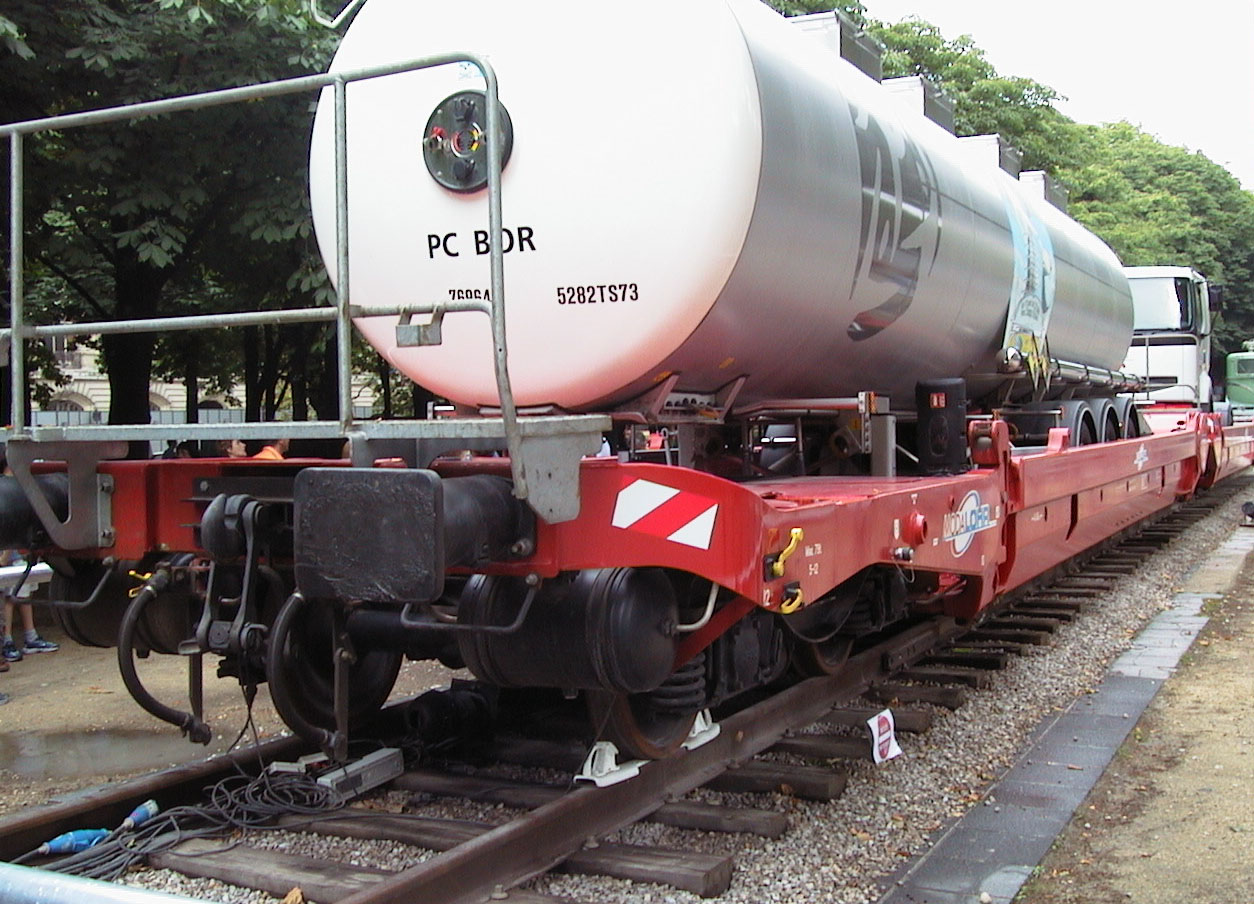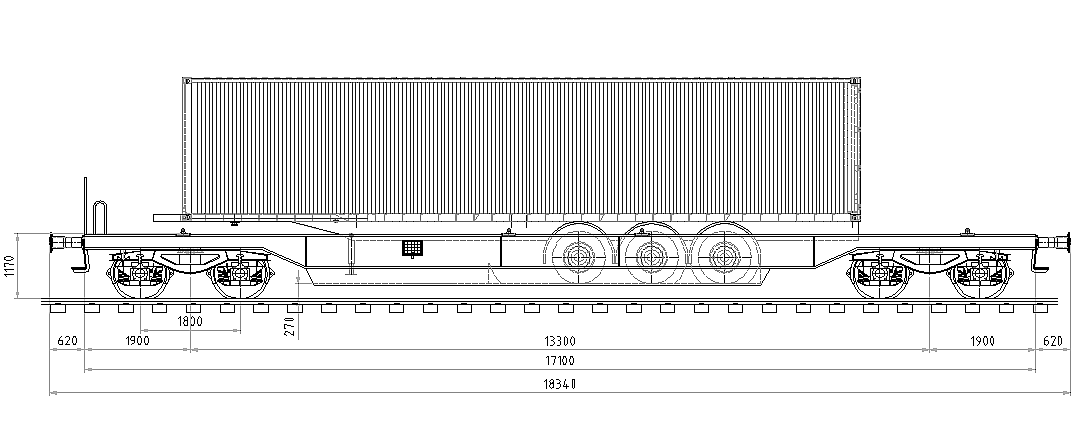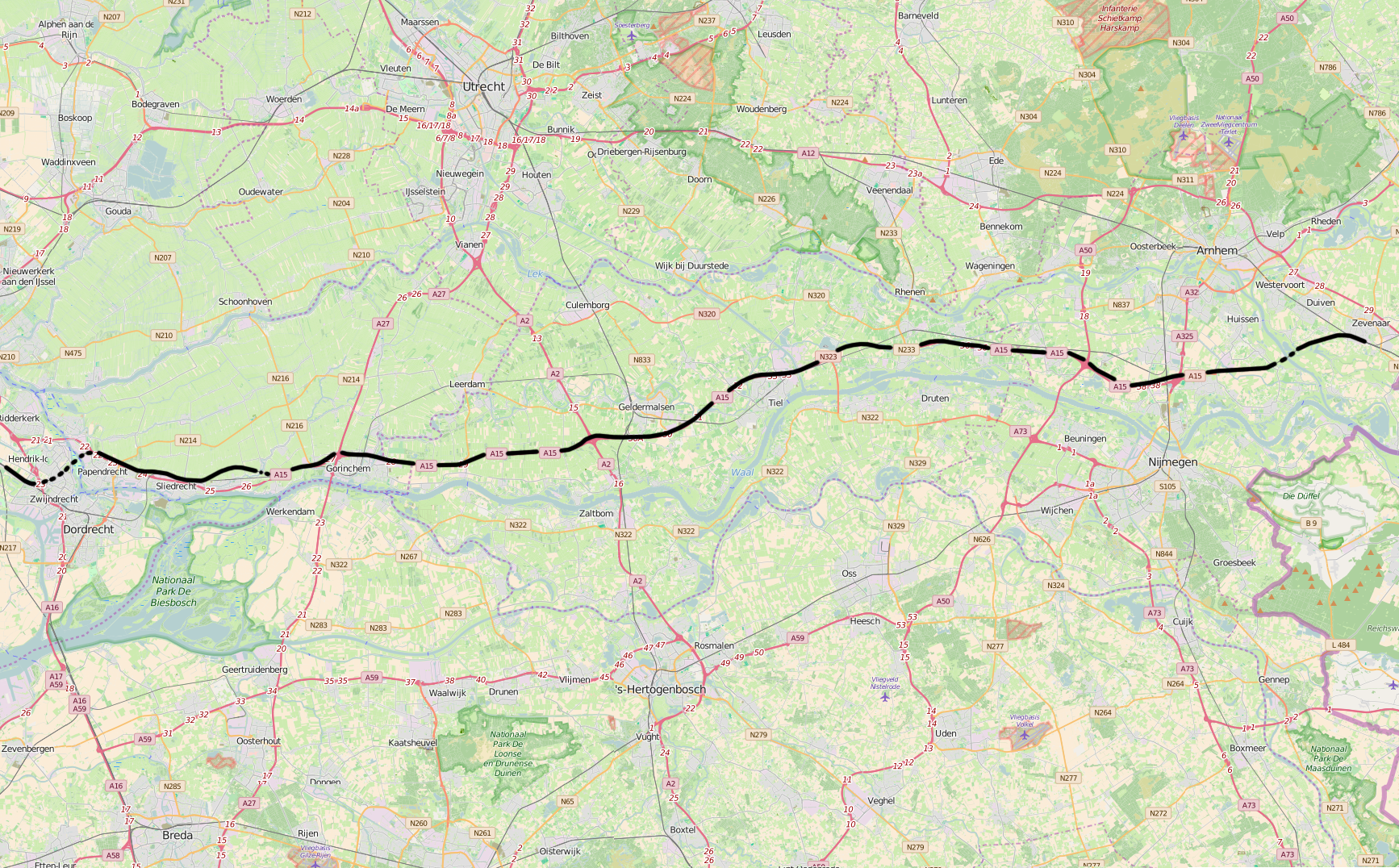|
Trailer-on-flatcar
Trailer on flatcar, also known as TOFC or piggyback, is the practice of carrying semi-trailers on railroad flatcars. TOFC allows for shippers to move truckloads long distances more cheaply than can be done by having each trailer towed by a truck, since one train can carry more than 100 trailers at once. The trailers will be moved by truck from their origin to an intermodal facility, where they will then be loaded onto a train, typically by a rubber tyred gantry crane, for the bulk of their journey. Alternatively, trailers may be driven onto the flatcars via ramps by a terminal tractor. Near the destination, the trailers are unloaded at another facility and brought to their final destination by a tractor unit. Modern TOFC service was first introduced in North America in the 1950s, although the practice was first recorded in 1843 when canal boats were moved by a portage railway between several cities in Pennsylvania. TOFC is distinct from containerization. While both are examples o ... [...More Info...] [...Related Items...] OR: [Wikipedia] [Google] [Baidu] |
Flatcar
A flatcar (US) (also flat car, or flatbed) is a piece of rolling stock that consists of an open, flat deck mounted on a pair of trucks (US) or bogies (UK), one at each end containing four or six wheels. Occasionally, flat cars designed to carry extra heavy or extra large loads are mounted on a pair (or rarely, more) of bogies under each end. The deck of the car can be wood or steel, and the sides of the deck can include pockets for stakes or tie-down points to secure loads. Flatcars designed for carrying machinery have sliding chain assemblies recessed in the deck. Flatcars are used for loads that are too large or cumbersome to load in enclosed cars such as boxcars. They are also often used to transport intermodal containers (shipping containers) or trailers as part of intermodal freight transport shipping. Specialized types Aircraft parts flatcars Aircraft parts were hauled via conventional freight cars beginning in World War II. However, given the ever-increasing size of ... [...More Info...] [...Related Items...] OR: [Wikipedia] [Google] [Baidu] |
Modalohr
The Lohr Railway System or Modalohr System (french: Système Modalohr) uses special railway wagons of a type known as piggyback wagons, to carry standard road semi-trailers on the European rail network.''Lohr Railway System'' at lohr.fr. Retrieved 23 Jun 2017. They are currently used on the AFF route from to and to the French border with Spain and vice versa. There are plans to expand this servi ... [...More Info...] [...Related Items...] OR: [Wikipedia] [Google] [Baidu] |
Double-stack Rail Transport
Double-stack rail transport is a form of intermodal freight transport in which railroad cars carry two layers of intermodal containers. Invented in the United States in 1984, it is now being used for nearly seventy percent of United States intermodal shipments. Using double stack technology, a freight train of a given length can carry roughly twice as many containers, sharply reducing transport costs per container. On United States railroads special well cars are used for double-stack shipment to reduce the needed vertical clearance and to lower the center of gravity of a loaded car. In addition, the well car design reduces damage in transit and provides greater cargo security by cradling the lower containers so their doors cannot be opened. A succession of larger container sizes have been introduced to further increase shipping productivity in the United States. Double-stack rail operations are growing in other parts of the world, but are often constrained by clearance and ot ... [...More Info...] [...Related Items...] OR: [Wikipedia] [Google] [Baidu] |
Double Stack Rail Transport
Double-stack rail transport is a form of intermodal freight transport in which railroad cars carry two layers of intermodal containers. Invented in the United States in 1984, it is now being used for nearly seventy percent of United States intermodal shipments. Using double stack technology, a freight train of a given length can carry roughly twice as many containers, sharply reducing transport costs per container. On United States railroads special well cars are used for double-stack shipment to reduce the needed vertical clearance and to lower the center of gravity of a loaded car. In addition, the well car design reduces damage in transit and provides greater cargo security by cradling the lower containers so their doors cannot be opened. A succession of larger container sizes have been introduced to further increase shipping productivity in the United States. Double-stack rail operations are growing in other parts of the world, but are often constrained by clearance and ot ... [...More Info...] [...Related Items...] OR: [Wikipedia] [Google] [Baidu] |
Intermodal Freight Transport
Intermodal freight transport involves the transportation of freight in an intermodal container or vehicle, using multiple modes of transportation (e.g., rail, ship, aircraft, and truck), without any handling of the freight itself when changing modes. The method reduces cargo handling, and so improves security, reduces damage and loss, and allows freight to be transported faster. Reduced costs over road trucking is the key benefit for inter-continental use. This may be offset by reduced timings for road transport over shorter distances. Origins Intermodal transportation has its origin in 18th century England and predates the railways. Some of the earliest containers were those used for shipping coal on the Bridgewater Canal in England in the 1780s. Coal containers (called "loose boxes" or "tubs") were soon deployed on the early canals and railways and were used for road/rail transfers (road at the time meaning horse-drawn vehicles). Wooden coal containers were first used on the ... [...More Info...] [...Related Items...] OR: [Wikipedia] [Google] [Baidu] |
Pocket Wagon
A pocket wagon is a freight wagon that has been specially designed for the transport of truck semi-trailers. This wagon belongs to the group of flat wagons in special design with bogies and is used in combined transport (CT). The name of these freight wagons comes from the fact that between the narrow longitudinal girders on the outside and also lengthways between the bogies, the so-called pockets are located, in which the wheels of the semi-trailers are particularly low. For flexible use in CT, pocket wagons have hinged latches with ISO spigots on the solebar, so that containers and swap bodies up to 45 ft can be accommodated'. As a flat wagon, it bears the UIC generic letter S and, since it is intended for the transport of road vehicles on one level, the code letter ''d''. Since it is also possible to transport containers in a pocket wagon, it bears the UIC generic mark ''Sdgs''. In this context, the code letter g stands for "containers up to 60 feet" and the lower case s for the ... [...More Info...] [...Related Items...] OR: [Wikipedia] [Google] [Baidu] |
Rolling Highway
In rail transportation, a rolling highway or rolling road is a form of combined transport involving the conveying of road trucks by rail, referred to as Ro-La trains. The concept is a form of piggyback transportation. The technical challenges to implement rolling highways vary from region to region. In North America, the loading gauge is often high enough to accommodate double stack containers, so the height of a semi-trailer on a flatcar is no issue. However, in Europe, except for purpose built lines such as the Channel Tunnel or the Gotthard Base Tunnel, the loading gauge height is much smaller, and it is necessary to transport the trailers with the tires about above the rails, so the trailers cannot be simply parked on the surface of a flat car above the wagon wheels or bogies. Making the wagon wheels smaller limits the maximum speed, so many designs allow the trailer to be transported with its wheels lower than the rail wagon wheels. An early approach in France was ... [...More Info...] [...Related Items...] OR: [Wikipedia] [Google] [Baidu] |
Kangourou Wagon
The '' 'kangaroo wagon' '' is a type of wagon rail designed for the transport of semi-trailers. It has a drawbridge forming a pocket in the low position (hence its name) allowing the carrier train (2 or 3 axles) of the semi-trailer to be placed and thus to respect the height of the loading gauge ( above top of rail for the loading gauge of the UIC). These are special open wagons. The axle models are UIC K type, their bogie S type counterparts. In France The '' 'kangaroo wagon' '' is the continuation of the UFR wagon. The latter no longer meeting transport requirements, a new type of wagon was studied for the transport of semi-trailer s but this time taking as a basis a standard trailer and not an adapted trailer. Axle wagon The first type of kangaroo wagon is a twin-axle model weighing of tare, having a length of and accepting a load of . This wagon is within the limits of load, length and wheelbase, fixed by the International Union of Railways (UIC), with a wheelbase ... [...More Info...] [...Related Items...] OR: [Wikipedia] [Google] [Baidu] |
Overhead Wire
An overhead line or overhead wire is an electrical cable that is used to transmit electrical energy to electric locomotives, trolleybuses or trams. It is known variously as: * Overhead catenary * Overhead contact system (OCS) * Overhead equipment (OHE) * Overhead line equipment (OLE or OHLE) * Overhead lines (OHL) * Overhead wiring (OHW) * Traction wire * Trolley wire This article follows the International Union of Railways in using the generic term ''overhead line''. An overhead line consists of one or more wires (or rails, particularly in tunnels) situated over rail tracks, raised to a high electrical potential by connection to feeder stations at regular intervals. The feeder stations are usually fed from a high-voltage electrical grid. Overview Electric trains that collect their current from overhead lines use a device such as a pantograph, bow collector or trolley pole. It presses against the underside of the lowest overhead wire, the contact wire. Current collectors are ... [...More Info...] [...Related Items...] OR: [Wikipedia] [Google] [Baidu] |
Ostthüringer Zeitung
The ''Ostthüringer Zeitung'' (OTZ) is a German newspaper covering eastern Thuringia with a head office in Gera. Together with the '' Thüringische Landeszeitung'' it has a daily circulation of 78,244 copies as of 2019, a 57.5% decrease since 1998. Since the early 1990s the OTZ has been printed daily except Sundays in eastern Thuringia by the publisher Ostthüringer Zeitung Verlag, which is owned 40% by the Funke Mediengruppe. Together with the ''Thüringer Allgemeine'' (TA) and the ''Thüringische Landeszeitung'' (TLZ), it is part of the "Zeitungsgruppe Thüringen" sales network. The total circulation of the three publications as of 2019 is 220,306 copies. In some areas, such as Gera, Jena and the Saale-Holzland district, the OTZ and TLZ appear in parallel. In Gera, the OTZ and TLZ produce a common local section that differs only in layout and design. In Jena the OTZ and TLZ exist separately in Jena are still formally separate but since 2009 have produced common local section wit ... [...More Info...] [...Related Items...] OR: [Wikipedia] [Google] [Baidu] |
Blue Banana
The Blue Banana (also known as the European Megalopolis or the Liverpool–Milan Axis) is a discontinuous corridor of urbanization spreading over Western and Central Europe, with a population of around 111 million. The conceptualisation of the area as a "Blue Banana" was developed in 1989 by RECLUS, a group of French geographers managed by Roger Brunet. It stretches approximately from North West England through the English Midlands across Greater London to the European Metropolis of Lille, the Benelux states with the Dutch Randstad and Brussels and along the German Rhineland, Southern Germany, Alsace-Moselle in France in the west and Switzerland (Basel and Zürich) to Northern Italy (Milan, Turin, and Genoa) in the south. History The French geographer Roger Brunet, who observed a division between "active" and "passive" spaces, developed the concept of a West European "backbone" in 1989. He made reference to an urban corridor of industry and services stretching from northern ... [...More Info...] [...Related Items...] OR: [Wikipedia] [Google] [Baidu] |
Betuweroute
The Betuweroute is a double track freight railway between Rotterdam and Germany. is the official name, after the Betuwe area through which the route passes. The line is popularly called Betuwelijn, after an older track in the same region. The line extends into Germany as the Oberhausen–Arnhem railway, and it is part of Project 5 of the Trans-European Transport Network (TEN-T). History In 1985 the Van Bonde Commission began to investigate the future of west–east transport. The main advocate of the proposed line was the then minister Neelie Kroes, later Commissioner in the European Union until 2014. In 1992 the German and Dutch governments signed the Treaty of Warnemünde, which addressed enhancing rail traffic and focused on the tracks from Amsterdam and Rotterdam to Duisburg. The original plan was for three branch rail lines towards Germany. The northern branch via Oldenzaal was abandoned in 1999 and the southern branch via Venlo was abandoned in 2004. Also in 2004, ... [...More Info...] [...Related Items...] OR: [Wikipedia] [Google] [Baidu] |







.jpg)
